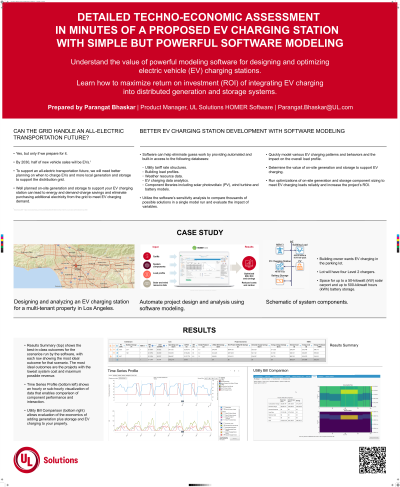Back

Electrification
Detailed Techno-Economic Assessment of an EV Charging Station
Detailed Techno-Economic Assessment of an EV Charging Station
Tuesday, September 12, 2023
4:30 PM - 5:30 PM PDT
Location: Poster Area, Booth #11024, Level 1, Venetian Expo Hall


Parangat Bhaskar (he/him/his)
Product Manager
UL Solutions | HOMER Software
Albany, New York, United States- TF
Poster Presenter(s)
Description and Background: Today the race is on to re-think how to charge the growing number of electric vehicles (EVs), while cutting energy costs and emissions. The solution lies in renewable, local generation. But how do you design and optimize the least-cost mix of distributed energy resources and energy storage to provide the cost savings and resiliency needed? Learn from a detailed look at the design and optimization process of a real-world microgrid to provide EV charging, resiliency and demand-charge reduction. In this case study, we will demonstrate how techno-economic modeling performed by computer software helps design a system to:
• Meet electric load demands reliably and for the least-cost
• Provide islanded power when the grid is down
• Model the role of energy storage in the power mix
• Optimize financial streams, including tariffs, demand-response programs and other incentive programs
Attendees will discover how energy-modeling of distributed energy resources provides insights into the best, least-cost microgrid solution so you can navigate the clean energy transition and save.
• Meet electric load demands reliably and for the least-cost
• Provide islanded power when the grid is down
• Model the role of energy storage in the power mix
• Optimize financial streams, including tariffs, demand-response programs and other incentive programs
Attendees will discover how energy-modeling of distributed energy resources provides insights into the best, least-cost microgrid solution so you can navigate the clean energy transition and save.
